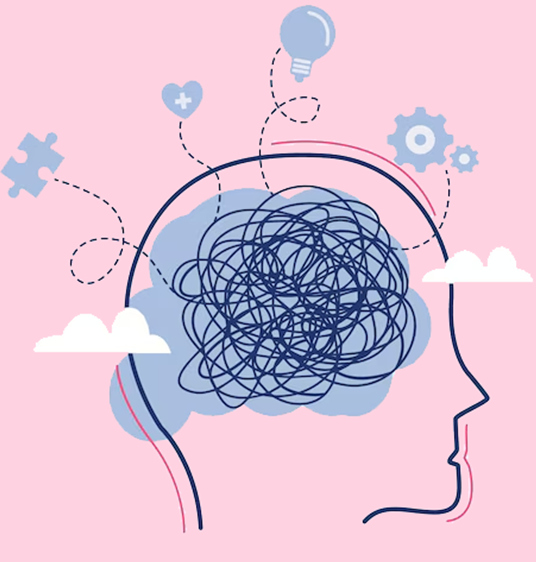
10-10-2024 (Important News Clippings)
To Download Click Here.
Mental health in India’s material world
India is facing a mental health epidemic, with the urban living, financial instability and fierce competition as significant contributors
Soumyajit Bhar and Kalpita Bhar Paul, [ Soumyajit Bhar is Assistant Professor and Assistant Dean (Admissions and Outreach) at the School of Liberal Studies, BML Munjal University. Kalpita Bhar Paul is an Assistant Professor of Philosophy at the School of Liberal Studies, BML Munjal University ]

India is currently witnessing a surge in mental health disorders. According to The Lancet Psychiatry Commission, over 197 million people suffer from conditions such as depression, anxiety and substance abuse. Economic growth has created new opportunities, but it has also intensified societal pressures and personal expectations. As India’s developmental aspirations rise, mental well-being is often overlooked, fuelling a crisis driven by materialism and a growing disconnect from community and self-awareness.
At the core of this crisis are existential questions that have guided human thought since the times of Socrates and Aristotle such as: Who am I? What is the purpose of my life? How should I live? Socrates said, “The unexamined life is not worth living”, highlighting the need for self-reflection. Aristotle linked the good life to eudaimonia — flourishing through virtuous living. Today, these essential inquiries are overshadowed by the pursuit of efficiency, productivity and material wealth. As India embraces consumerism, this focus on affluence distances individuals from deeper self-reflection, exacerbating the mental health crisis.
Rising stress and anxiety
India is grappling with a mental health epidemic, with millions suffering from disorders such as depression and anxiety. The relentless pressures of urban living, financial instability, and fierce competition are significant contributors. Even those who achieve material success often find that wealth and status do not deliver true well-being. Instead, many feel isolated and disconnected from their communities, experiencing a profound sense of purposelessness. While material wealth provides temporary comfort, it fails to meet deeper emotional and psychological needs. The growing focus on consumerism, particularly in urban areas, has fostered a culture where luxury and conspicuous goods define status. This leads to feelings of inadequacy, stress and social comparison. As Ernest Becker noted, much of human behaviour is driven by the fear of impermanence and insignificance. People chase material wealth for social validation, hoping it will bring lasting happiness, but this pursuit neglects self-awareness. The endless quest for affluence disconnects individuals from the essential elements of a meaningful life — self-awareness, purpose, and meaningful relationships — trapping them in a cycle of dissatisfaction.
To break this cycle, we must rethink what constitutes a good life. Current political and economic priorities reinforce the belief that wealth and consumption equate to happiness. This mindset shapes societal norms, encouraging consumption-driven choices that further entrench the mental health crisis.
Collective action, community as solutions
To address this crisis, we must shift focus from individual success to collective well-being. Studies show that strong social connections, supportive communities, and meaningful work are critical to mental health. However, work-life balance and legal protection are increasingly under threat. The socio-political climate in India, where young individuals desperately strive for a consumeristic “good life”, has led to proposals such as extended work hours. For instance, the Karnataka Shops and Commercial Establishments (Amendment) Bill 2024 permits employees to work more than 12 hours a day, up to 125 hours in three months. Amid rapid urbanisation and personal achievement, it is essential to remind ourselves of the deeper meaning and purpose in life that can be found through community, joy, and friendship.
Examples from other countries offer lessons. In Brazil, community gardens have helped residents reconnect by sharing responsibilities and fostering a sense of belonging. Similar initiatives in India could counteract the isolation fostered by urban living and consumerism, bringing people together to create stronger social bonds.
Improving mental health requires embracing community-oriented living that challenges the individualised lifestyle promoted by consumer culture. Modern consumerism equates freedom with personal consumption, weakening social bonds that traditionally held communities together. In contrast, community living fosters a sustainable alternative — shared responsibility, collective purpose, and mutual support create an environment that nurtures emotional and psychological well-being. In community settings, people share resources and experiences, reducing the pressure to compete for individual success. This strengthens social support networks and reintroduces the value of interdependence, where well-being is measured by relationships and contributions to the group rather than personal wealth. Unlike the isolation and comparison promoted by consumer culture, community living fosters empathy, mindfulness, and human connection, providing fulfilment through shared experiences. These environments offer a sense of belonging, purpose, and security, all of which are crucial for reducing stress and mental health issues.
Consumer choice and liberty
A significant contributor to India’s mental health crisis is the reduction of freedom to consumer choice. As India’s middle class expands, many equate their ability to buy goods with personal freedom and success. However, this perspective prioritises material wealth over deeper values such as equality and fraternity. The result is a society where happiness is measured by buying power, leading to an endless cycle of consumption that does little to improve long-term mental health.
By reducing freedom to consumer choice, individuals feel growing inadequacy, unable to meet rising standards of success. In contrast, prioritising connection, community, and equity provides a healthier foundation for both personal well-being and societal progress.
Addressing India’s mental health crisis requires rethinking what it means to live a good life. We must challenge the materialistic notion of success and refocus on mental, emotional, and social well-being. The solution lies in adopting alternative pathways that prioritise community and collective action over individual wealth accumulation.
Programmes that promote mindfulness, social-emotional learning, community living, and mental health awareness are essential for creating a culture that values mental well-being. Additionally, social policies that reduce inequality and provide mental health support are crucial to address the crisis.
A truly good life is not about how much we can buy or achieve, but about how we relate to ourselves, our communities, and our environment. By prioritising community, equity, and mental well-being, we can build a healthier, more connected society where people feel supported and valued. Only by addressing the root causes of the mental health crisis can we pave the way for a more meaningful and fulfilling future for all.
Date: 10-10-24
Transform workplaces into supportive spaces
The belief system where success is tied to a brutal work culture needs to be phased out
P. John J. Kennedy, [ P. John J. Kennedy is Professor and Dean, Christ University, Bengaluru ]

A competitive economy
The reason behind this brutal work culture is clear: profit. In today’s competitive economy, businesses focus on cost-cutting, efficiency and productivity. As a result, employees come under immense pressure to meet unrealistic expectations, often working long hours and under strenuous conditions. Many organisations have adopted a belief system where success is tied to a “hustle and bustle” culture, assuming that perpetual activity will lead to better results.
This mindset is not new. Some scholars believe that the roots of this work obsession can be traced back to Max Weber’s influential work, The Protestant Ethic and the Spirit of Capitalism, which links hard work with moral virtue. According to Weber, success and diligence were not just signs of professional capability, but of moral worth. Today, unfortunately, this ethos thrives in high-stakes industries such as technology, finance and law, where not just hard work but also overwork is celebrated and even glorified. The consequences are devastating.
Cognitive dissonance theory, a psychological concept, helps explain how employers justify this gruelling work environment. Once overwork becomes normalised, employers may rationalise it as beneficial or even essential for organisational growth. From a business standpoint, the belief often emerges that pushing employees to their limits will filter out the “weak” and reward the “strong”, fostering a culture of hyper-competition. However, this distorted view ignores the steep human cost. Chronic stress leads to burnout, anxiety, depression, and, tragically, suicide in some cases.
Importance of employee well-being
This myopic understanding of work and success prevents companies from considering alternative models that prioritise employee well-being, although research has consistently shown that happier employees are more productive. The Human Relations Movement, which began in the early 20th century, underscored the importance of employee satisfaction in improving organisational efficiency. This perspective has slowly regained traction today, as more companies are embracing flexible work hours, mental health initiatives and policies to promote work-life balance. The challenge now is to move beyond profit maximisation to a long-term view that treats human capital as a core asset.
So, how do we get there? While dismissing this as wishful thinking is tempting, meaningful change is possible. The first step for companies is to reassess their work culture and expectations. Employers should reduce excessive working hours, offer flexible schedules, and embrace remote work when possible. Studies have shown that employees with more control over their schedules report higher job satisfaction and reduced stress levels. Encouraging regular breaks and vacations is also vital in preventing burnout. Equally important is providing psychological support. Companies should invest in employee assistance programmes and ensure that mental health professionals are accessible. Psychological research has proven that early intervention can dramatically reduce the long-term effects of workplace stress. It is also crucial to foster open conversations around mental health, eliminating the stigma that often surrounds seeking help.
Focus on work quality
Supervisors and managers are pivotal to driving this transformation. They must be trained to recognise signs of burnout, such as emotional exhaustion or disengagement, and intervene before problems escalate. A culture where mental health check-ins are routine and stress management is prioritised can create a healthier and more sustainable workforce. Additionally, companies should shift their focus away from measuring productivity solely based on the quantity of time spent or deadlines met. Instead, performance metrics should emphasise the quality of work. This approach would help create an environment where output is valued for its depth and impact rather than sheer volume. Lastly, the deeply ingrained myth that constant busyness equates to productivity must be debunked. A balanced and sustainable work culture benefits employees and their organisations. Employers should set realistic expectations, and employees must feel empowered to set boundaries around their work hours. This includes saying “no” when workloads become unmanageable, a daunting but necessary step in maintaining mental health.
The issue of workplace stress is both societal and personal. Addressing it requires collective effort. While employees can build resilience through mindfulness, regular exercise and strong social support networks, seeking professional help should never be delayed when stress becomes overwhelming. Employers and employees must take concrete steps to break the cycle of overwork and promote a culture that values holistic well-being. Only by doing so can we achieve sustainable productivity and a future where life is valued above profit.
खराब होने वाली फसलों के प्रबंधन पर ध्यान जरूरी
संपादकीय
इस हफ्ते की शुरुआत में दिल्ली में कुछ जगहों पर टमाटर 120- 130 रुपए किलो बिके। केन्द्रीय उपभोक्ता मंत्रालय ने कई केन्द्रों से सब्सिडी देकर 60 रुपए किलो टमाटर बेचना शुरू किया। लेकिन यह समस्या का स्थाई समाधान नहीं है। छह वर्ष पहले ‘टॉप’ (टोमैटो, अनियन, पोटेटो यानी टमाटर, प्याज और आलू) योजना की घोषणा से लगा कि गरीब को भी संतुलित विटामिन, फाइबर और माइक्रो- न्यूट्रीएंट्स से भरपूर तीनों सब्जियां सुलभ मिलेंगी। लेकिन आज भी रखरखाव के लिए कोल्ड चेन और विपणन के लिए शोषण – शून्य संस्थागत ढांचे के अभाव में किसानों ने इन सब्जियों को बोना कम कर दिया है। तापमान के ज्यादा होने और समय से पूर्व या बाद में भीषण गर्मी के कारण भी किसान इन दिनों टमाटर बोने से हट रहा है। और उसकी जगह मौसम से कम प्रभावित होने वाला मक्का या ऐसा ही अन्य अनाज पैदा करने लगा है। सरकारी आंकड़ों के अनुसार इस खरीफ सीजन के 20 सितंबर तक टमाटर 2.89 लाख हेक्टेयर में पैदा करने के लक्ष्य की जगह मात्र 1.98 लाख हेक्टेयर बोया जा सका था। रबी सीजन में भी अगर गर्मी ज्यादा दिनों तक चली तो किसान नुकसान के डर से ऐसी फसलें बोने से बचेगा। जब तक मौसम की मार से जल्द खराब होने वाले जिंसों का उचित प्रबंधन नहीं होगा, किसान उन्हें बोने से कतराएगा।
एक्ट ईस्ट को साकार करता भारत
श्रीराम चौलिया, ( स्तंभकार अंतरराष्ट्रीय मामलों के विशेषज्ञ एवं ‘फ्रेंड्स: इंडिया’ज क्लोजेस्ट स्ट्रैटेजिक पार्टनर्स’ के लेखक हैं )
प्रधानमंत्री नरेन्द्र मोदी 21वें भारत-आसियान शिखर सम्मेलन और 19वें पूर्वी एशिया शिखर सम्मेलन में भाग लेने के लिए लाओस जा रहे हैं। वैसे तो प्रति वर्ष इन दोनों सम्मेलनों में प्रधानमंत्रियों की उपस्थिति आम है, लेकिन इस साल भारत की एक्ट ईस्ट नीति यानी कि पूर्वी छोर को साधने की पहल के दस वर्ष पूरे होने के चलते यह पड़ाव विशेष मायने रखता है। वर्ष 2014 में मोदी सरकार ने 1992 से लागू लुक ईस्ट नीति को गतिशील और व्यापक बनाने के उद्देश्य से उसका नामांतरण एक्ट ईस्ट के रूप में किया। पिछले एक दशक के घटनाक्रम के आधार पर कहा जा सकता है कि यह कोई सतही बदलाव नहीं था। एक्ट ईस्ट के तहत भारत ने व्यापार, सैन्य और सांस्कृतिक कार्यक्षेत्रों में दक्षिण पूर्वी एशिया (आसियान के दस देशों), उत्तर पूर्वी एशिया (जापान, कोरिया और मंगोलिया) तथा ओशनिया (आस्ट्रेलिया, न्यूजीलैंड और पैसिफिक द्वीपीय देश) के साथ संबंधों को प्रगाढ़ बनाया है। इसी दौरान भारत ने अमेरिका के साथ अपनी सामरिक साझेदारी भी मजबूत की है, जिसका सीधा सरोकार पूर्वी एशिया के आर्थिक और भूराजनीतिक परिदृश्य से है।
एक्ट ईस्ट के युग में भारत पूर्वी एशिया में गहरी पैठ बना चुका है। भारत कभी केवल दक्षिण एशियाई देश कहलाता था, लेकिन अब पूर्वी एशिया की नियति तय करने में बड़ी भूमिका निभा रहा है। जिस इलाके में कभी केवल चीन और अमेरिका को ही प्रमुख और निर्णायक शक्ति माना जाता था, आज वहां भारत की साख बढ़ी है और वह आगे और भी ज्यादा प्रभावी होने वाली है। ऑस्ट्रेलिया के लोवी इंस्टीट्यूट नामक शोध संस्थान ने 2024 के एशिया शक्ति सूचकांक में अमेरिका और चीन के बाद भारत को सबसे शक्तिशाली देश का दर्जा दिया है। यह बात पूर्वी एशिया के विभिन्न देशों से छिपी नहीं है कि उनके क्षेत्र में संतुलन कायम करने के लिए भारत अहम खिलाड़ी है। 2004 में सिंगापुर के तत्कालीन प्रधानमंत्री गोह चोक टोंग ने कहा था कि आसियान अगर हवाई जहाज का ढांचा है तो चीन उसका एक पंख है और भारत दूसरा पंख और इन दोनों पंखों के बगैर उड़ान नहीं भरी जा सकती।
आज एक्ट ईस्ट के अंतर्गत भारत-आसियान द्विपक्षीय कारोबार 2014 की तुलना में दोगुना होकर 131 अरब डालर के स्तर पर पहुंच गया है। आसियान ने भारत को सामरिक साझेदार से ऊपर व्यापक सामरिक साझेदार का भी दर्जा दिया है। हालांकि पूर्वी एशियाई देशों को उम्मीद थी कि 2022 में हुए क्षेत्रीय व्यापक आर्थिक भागीदारी यानी आरसेप समझौते में भारत भी शामिल होगा और उससे उन्हें भारत के विशाल बाजार में अधिक अवसर मिलेंगे। लेकिन, आसियान देशों के साथ भारत का व्यापार घाटा और उनके यहां चीन के भारी निवेश के कारण भारत ने उस समझौते से परहेज किया। दूसरी तरफ अमेरिका ने चीन से प्रतिस्पर्धा तेज करने के मकसद से 2022 में ही इंडो पैसिफिक आर्थिक ढांचा (आईपीईएफ) बनाया था, जिसमें भारत संस्थापक सदस्य बना। आरसेप को ठुकराने की क्षतिपूर्ति आईपीईएफ द्वारा करना भारतीय विदेश नीति के लिए चुनौती है।
अमेरिका के साथ भारत की बढ़ती नजदीकी पूर्वी एशिया को परस्पर आर्थिक फायदे की स्थिति में लाने के साथ-साथ क्षेत्रीय सुरक्षा में भी इजाफा करेगी। इस क्षेत्र में अमेरिका को अव्वल रक्षा सहभागी और चीन को प्राथमिक आर्थिक सहभागी माना गया है, पर चीन ने बीते दशक में विस्तारवादी व्यवहार और धमक से अपने से छोटे देशों को दहशत में डाल रखा है। आए दिन फिलीपींस, वियतनाम, इंडोनेशिया, ताइवान और जापान पर चीन क्षेत्रीय दावा करता है और सैन्य बल से उन पर हावी होने की चेष्टा करता है। ऐसे में भारत अकेले पूर्वी एशिया जैसे दूरस्थ एवं विस्तारित क्षेत्र में चीन का प्रतिरोध नहीं कर सकता। भारत, अमेरिका, जापान और आस्ट्रेलिया ने क्वाड समूह को 2017 से पुनः सक्रिय किया है। क्वाड सैन्य गठबंधन नहीं है, लेकिन उसका लक्ष्य नियम और अंतरराष्ट्रीय विधि आधारित क्षेत्रीय व्यवस्था बनाना है। साफ शब्दों में क्वाड पूर्वी एशिया के चीन-केंद्रित होने के विरुद्ध खड़ा है। अमेरिका, ब्रिटेन और आस्ट्रेलिया के मध्य घोषित आकस गठबंधन और अमेरिका, जापान, आस्ट्रेलिया और फिलीपींस के मध्य स्क्वाड का भी भारत ने समर्थन किया है। इन नए समूहों के साथ मिल-जुलकर भूराजनीतिक संतुलन बनाने में भारत का ही हित है। हालांकि ऐसे गुटों के साथ सहयोग का यह मतलब नहीं है कि भारत केवल अमेरिका और उसके मित्रों पर ही पूरी तरह निर्भर रहेगा।
लुक ईस्ट की तुलना में एक्ट ईस्ट नीति में भारत ने रक्षा के मुद्दे को अधिक उभारा है और हिंद-प्रशांत में नए त्रिकोणीय समीकरणों का सृजन किया है। इसी के मद्देनजर भारत-इंडोनेशिया-आस्ट्रेलिया, भारत-फ्रांस-आस्ट्रेलिया और भारत-सिंगापुर-थाइलैंड जैसे उपयोगी संयोजन कुछ वर्षों से क्रियाशील हुए हैं। इसी कड़ी में अगर भारत-जापान-दक्षिण कोरिया और भारत-वियतनाम-इंडोनेशिया के भी त्रिकोणीय गुट बन जाएं तो भारत न सिर्फ हिंद महासागर में सुरक्षा प्रदाता के रूप में रहेगा, बल्कि समूचे हिंद-प्रशांत का नेतृत्व भी कर सकेगा। देखें तो एक्ट ईस्ट के दस वर्षों के दौरान एशिया-प्रशांत हिंद-प्रशांत में तब्दील हुआ है और इस परिवर्तन के प्रति चीन के अलावा अधिकतर देश सकारात्मक दृष्टिकोण रखते हैं। अब हिंद-प्रशांत की अवधारणा को सफल बनाने के लिए भारत को अपनी हिंद-प्रशांत सागर पहल (आइपीओआई) और अन्य देशों के हिंद-प्रशांत दृष्टिकोणों के बीच तालमेल बनाना होगा। भारत को चीन के खतरे का सामना करते हुए यथार्थवाद और रणनीतिक सूझबूझ के सहारे आगे बढ़ना होगा।
